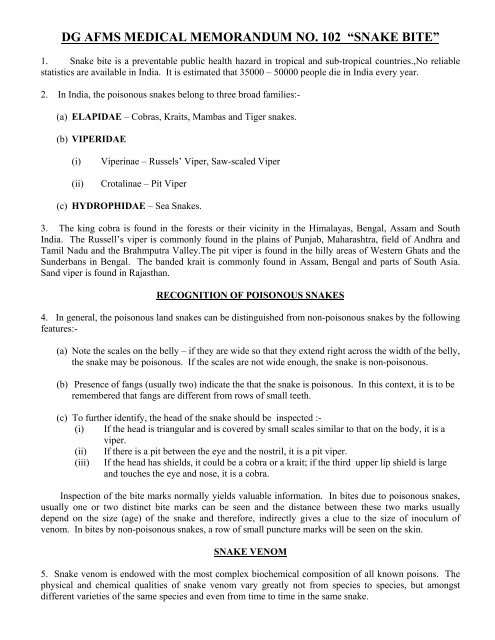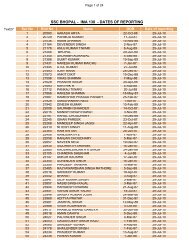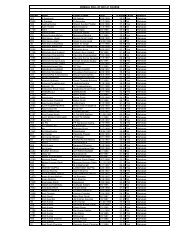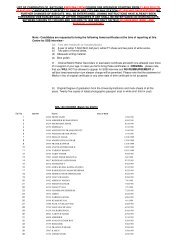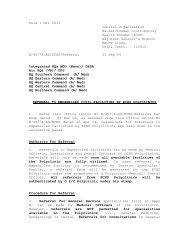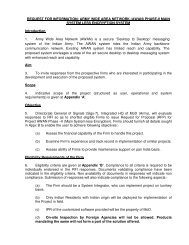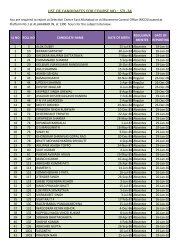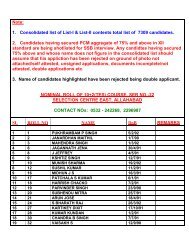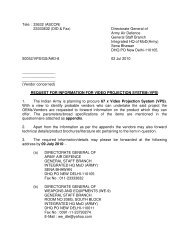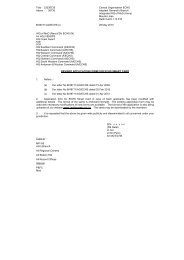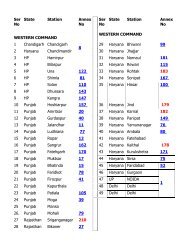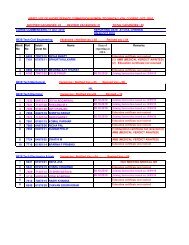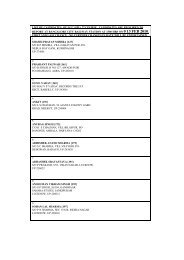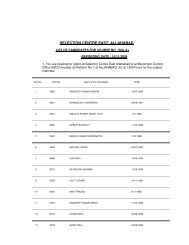snake bite - Indian Army
snake bite - Indian Army
snake bite - Indian Army
You also want an ePaper? Increase the reach of your titles
YUMPU automatically turns print PDFs into web optimized ePapers that Google loves.
DG AFMS MEDICAL MEMORANDUM NO. 102 “SNAKE BITE”<br />
1. Snake <strong>bite</strong> is a preventable public health hazard in tropical and sub-tropical countries.,No reliable<br />
statistics are available in India. It is estimated that 35000 – 50000 people die in India every year.<br />
2. In India, the poisonous <strong>snake</strong>s belong to three broad families:-<br />
(a) ELAPIDAE – Cobras, Kraits, Mambas and Tiger <strong>snake</strong>s.<br />
(b) VIPERIDAE<br />
(i) Viperinae – Russels’ Viper, Saw-scaled Viper<br />
(ii) Crotalinae – Pit Viper<br />
(c) HYDROPHIDAE – Sea Snakes.<br />
3. The king cobra is found in the forests or their vicinity in the Himalayas, Bengal, Assam and South<br />
India. The Russell’s viper is commonly found in the plains of Punjab, Maharashtra, field of Andhra and<br />
Tamil Nadu and the Brahmputra Valley.The pit viper is found in the hilly areas of Western Ghats and the<br />
Sunderbans in Bengal. The banded krait is commonly found in Assam, Bengal and parts of South Asia.<br />
Sand viper is found in Rajasthan.<br />
RECOGNITION OF POISONOUS SNAKES<br />
4. In general, the poisonous land <strong>snake</strong>s can be distinguished from non-poisonous <strong>snake</strong>s by the following<br />
features:-<br />
(a) Note the scales on the belly – if they are wide so that they extend right across the width of the belly,<br />
the <strong>snake</strong> may be poisonous. If the scales are not wide enough, the <strong>snake</strong> is non-poisonous.<br />
(b) Presence of fangs (usually two) indicate the that the <strong>snake</strong> is poisonous. In this context, it is to be<br />
remembered that fangs are different from rows of small teeth.<br />
(c) To further identify, the head of the <strong>snake</strong> should be inspected :-<br />
(i) If the head is triangular and is covered by small scales similar to that on the body, it is a<br />
viper.<br />
(ii) If there is a pit between the eye and the nostril, it is a pit viper.<br />
(iii) If the head has shields, it could be a cobra or a krait; if the third upper lip shield is large<br />
and touches the eye and nose, it is a cobra.<br />
Inspection of the <strong>bite</strong> marks normally yields valuable information. In <strong>bite</strong>s due to poisonous <strong>snake</strong>s,<br />
usually one or two distinct <strong>bite</strong> marks can be seen and the distance between these two marks usually<br />
depend on the size (age) of the <strong>snake</strong> and therefore, indirectly gives a clue to the size of inoculum of<br />
venom. In <strong>bite</strong>s by non-poisonous <strong>snake</strong>s, a row of small puncture marks will be seen on the skin.<br />
SNAKE VENOM<br />
5. Snake venom is endowed with the most complex biochemical composition of all known poisons. The<br />
physical and chemical qualities of <strong>snake</strong> venom vary greatly not from species to species, but amongst<br />
different varieties of the same species and even from time to time in the same <strong>snake</strong>.
Snake venom contains a mixture of powerful enzymes and non-enzymatic proteins and polypeptidases.<br />
6. The important venom constituent effects could be seen in variable combinations:-<br />
a)PROCOAGULANT ENZYMES (Viperidaepredominantly ).<br />
b)HEMORRHAGINS<br />
c)CYTOLYTIC/NECROTIC TOXINS<br />
d)HAEMOLYTIC TOXINS<br />
e)MYOLYTIC ENZYMES<br />
f)PRE SYNAPTIC NEUROTOXINS (Elapidae and some viperidae)<br />
g)POST SYNAPTIC NEUROTOXINS. (elapidae)<br />
2<br />
FACTORS WHICH DETERMINE THE SEVERITY OF ENVENOMATION<br />
7. a) This is variable and depends on species, size of <strong>snake</strong>, <strong>bite</strong> efficiency, one fang or two fangs,<br />
numbers of strikes and intention of <strong>snake</strong>. 50% of Rusell viper <strong>bite</strong>s, 30% of cobra <strong>bite</strong>s and 10% saw<br />
scaled viper <strong>bite</strong>s do not cause envenomation. However, <strong>snake</strong>s do not exhaust venom stores either after<br />
multiple <strong>bite</strong>s or after eating prey. Larger <strong>snake</strong>s do tend to inject more venom than smaller <strong>snake</strong>s of same<br />
species but small young vipers have venom rich in procoagulants and haemmorhagins.<br />
(b) Other factors are :-<br />
(i) Age : Envenomation in children is usually serious because there is greater concentration of<br />
venom per unit of body weight.<br />
(ii)Bite : Bites on extremities or into adipose tissue are less dangerous than those on the trunk, face<br />
or directly into a blood vessel.<br />
(iii) Mode of Bite : Direct strike of the fangs is more dangerous than scratch, a glancing blow or one<br />
hitting a bone. A <strong>bite</strong> through clothing affords good protection.<br />
(iv) Physical Exertion : Running immediately after the <strong>bite</strong> enhances systemic absorption of the<br />
toxin.<br />
(v) Characteristics of the Snake: The amount of venom injected depends on the extents of anger and<br />
fear of the <strong>snake</strong>; the condition of the fangs (whether broken or recently renewed); the condition of<br />
venom glands whether full or recently discharged) and the size of the <strong>snake</strong>.
8. How do <strong>snake</strong> <strong>bite</strong>s happen?<br />
3<br />
Service personnel while camping are at high risk. Snake <strong>bite</strong> is an occupational hazard of rice farmers and<br />
those who handle <strong>snake</strong>s<br />
9. How can <strong>snake</strong> <strong>bite</strong>s be avoided ?<br />
Snake <strong>bite</strong> is an occupational hazard that is very difficult to avoid completely. However, attention to the<br />
following recommendations might reduce the number of accidents.<br />
i) Education ! Know your local <strong>snake</strong>s, know the sort of places where they like to live and<br />
hide, know at what times of year, at what times of day/night or in what kinds of weather<br />
they are most likely to be active.<br />
ii) Be specially vigilant about <strong>snake</strong> <strong>bite</strong>s after rains, during flooding, at harvest time and at<br />
night.<br />
iii) Try to wear proper shoes or boots and long trousers, especially when walking in the dark or<br />
in undergrowth.<br />
iv) Use light (torch, flashlight or lamp) when walking at night.<br />
v) Avoid <strong>snake</strong>s as far as possible, including <strong>snake</strong>s performing for <strong>snake</strong> charmers. Never<br />
handle, threaten or atttack a <strong>snake</strong> and never intentionally trap or corner a <strong>snake</strong> in an<br />
enclosed space.<br />
vi) If at all possible, try to avoid sleeping on the ground.<br />
vii) Keep young children away from areas known to be <strong>snake</strong>-infested.<br />
viii) Avoid or take great care handling dead <strong>snake</strong>s that appear to be dead.<br />
ix) Avoid having rubble, termite mounds or domestic animals close to human dwellings, as all<br />
of these attract <strong>snake</strong>s.<br />
x) avoid types of house construction that will provide <strong>snake</strong>s with hiding places<br />
xi) Check shoes, coat pockets prior to use in endemic areas.<br />
xii) Observe standard anti <strong>snake</strong> precautions while camping.<br />
xiii) To prevent sea <strong>snake</strong> <strong>bite</strong>s, fishermen, sailors and bathers should avoid touching sea <strong>snake</strong>s<br />
caught in nets and on lines
10.a When venom has not been injected<br />
4<br />
SYMPTOMS AND SIGNS OF SNAKE BITE<br />
Some people who are bitten by <strong>snake</strong>s or suspect or imagine that they have been bitten, may develop quite<br />
striking symptoms and signs, even when no venom has been injected. This results from understandable<br />
fear of the consequences of a real venomous <strong>bite</strong>. Anxiety may lead to hyperventilation , paraesthesiae,<br />
and even tetany. Vasovagal reactions, Panic reactions, agitatation and a wide range of misleading<br />
symptoms. after the <strong>bite</strong> or suspected <strong>bite</strong>,may be seen.<br />
Another source of symptoms and signs not caused by <strong>snake</strong> venom is first aid and traditional treatments..<br />
10.b When venom has been injected<br />
i Early symptoms and signs<br />
Following the immediate pain of the <strong>bite</strong>, there may be increasing local pain (burning, bursting,<br />
throbbing) at the site of the <strong>bite</strong>, local swelling that gradually extends proximatelly up the bitten<br />
limb and tender, painful enlargement of the regional lymph nodes draining the site of the <strong>bite</strong><br />
However, <strong>bite</strong>s by kraits, sea <strong>snake</strong>s may be virtually painless and may cause negligible local<br />
swelling. Someone who is sleeping may not even wake up when bitten by a krait and there may be<br />
no detectable fang marks or signs of local envenoming.<br />
ii Clinical pattern of envenoming by <strong>snake</strong>s<br />
a) Symptoms and signs vary according to the species of <strong>snake</strong>s responsible for the <strong>bite</strong><br />
and the amount of venom injected. However, the venom may have a variable<br />
composition of various poisons , which is not always totally species specific<br />
b) If the biting species is unknown, recognition of the emerging pattern of symptoms,<br />
signs and results of laboratory tests (“the clinical syndrome”), may suggest which<br />
species was responsible.<br />
iii Local symptoms and signs in the bitten part<br />
fang marks<br />
local pain<br />
local bleeding<br />
bruising<br />
lymphangitis<br />
lymph node enlargement<br />
inflammation (swelling, redness, heat)<br />
blistering<br />
local infection, abscess formation<br />
necrosis<br />
iv Generalised (systemic) symptoms and signs<br />
General<br />
Nausea, vomiting, malaise, abdominal pain, weakness, drowsiness, prostration
5<br />
Cardiovascular (Viperidae)<br />
dizziness, faintness, collapse, shock, hypotension, cardiac arrhythmias, pulmonary oedema, cardiac<br />
arrest<br />
Bleeding and clotting disorders (viperidae)<br />
-bleeding from recent wounds (including fang marks, venepunctures etc) and from old partly-healed<br />
wounds.<br />
-spontaneous systemic bleeding – from gums, epistaxis, bleeding into the tears, haemoptysis,<br />
haematemesis, rectal bleeding or melaena, haematuria, vaginal bleeding, bleeding into the skin<br />
(petechiae, purpura, ecchymoses) and mucosae<br />
[e.g. conjunctivae, intracranial haemorrhage (meningism from subarachnoid haemorrhage,<br />
lateralising signs and/or coma from cerebral haemorrhage<br />
Neurological (Elapidae, Russells’s viper)<br />
Drowsiness, paraesthesiae, abnormalities of taste and smell, “heavy” eyelids, ptosis, external<br />
ophthalmoplegia, paralysis of facial muscles , difficulty in opening mouth and showing tongue and<br />
weakness of other muscles innervated by the cranial nerves, aphonia, difficullty in swallowing<br />
secretions, respiratory and generalised flaccid paralysis<br />
Skeletal muscle breakdown (sea <strong>snake</strong>s, Russell’s viper) Generalised pain, stiffness and tenderness<br />
of muscles, trismus, myoglobinuria hyperkalaemia, cardiac arrest, acute renal failure<br />
Renal (Viperidae, sea <strong>snake</strong>s)Loin (lower back) pain, haematuria, haemoglobinuria, myoglobinuria,<br />
oliguria/anuria, symptoms and signs of uraemia (acidotic breathing, hiccups, nausea, pleuritic chest<br />
pain etc)<br />
Endocrine (acute pituitary/adrenal insufficiency) (Russell’s viper)<br />
Acute phase : shock, hypoglycaemia<br />
Chronic phase (months to year after the <strong>bite</strong>) : weakness, loss of secondary sexual hair,<br />
amenorrhoea, testicular atrophy, hypothyroidism and hypopituitarism etc.<br />
10.c Clinical syndromes of <strong>snake</strong> <strong>bite</strong><br />
Syndrome 1<br />
Local envenoming (swelling etc) with bleeding/clotting disturbances.<br />
= Viperdae (all species)<br />
Syndrome 2<br />
Local envenoming (swelling etc) with bleeding/clotting disturbances, shock or renal failure<br />
= Russell’s viper (and possibly saw-scaled viper – echis species – in some areas)<br />
with conjunctival oedema (chemosis) and acute pituary insufficiency<br />
= Russell’s viper, Myanmar, NE India<br />
with ptosis, external opthalmoplegia, facial paralysis etc and dark brown urine<br />
=Russell’s viper, Sri Lanka and South India
Syndrome 3<br />
Local envenoming (swelling etc) with paralysis<br />
=cobra or king cobra<br />
Syndrome 4<br />
6<br />
Paralysis with minimal or no local envenoming <strong>bite</strong> on land while sleeping outside = Krait<br />
Bite in the sea = sea <strong>snake</strong><br />
Syndrome 5<br />
Paralysis with dark brown urine and renal failure :<br />
Bite on land (with bleeding/clotting disturbance) = Russell’s viper, Sri<br />
Lanka/South India<br />
Bite in the sea (no bleeding/clotting disturbance) = Sea <strong>snake</strong><br />
ii Limitations of syndromic approach<br />
The range of activities of a particular venom are widely variable. For example, some elapid<br />
venoms, such as those of Asian cobras, can cause severe local envenoming, formerly thought to be<br />
an effect only of viper venoms. In Sri Lanka and South India, Russell’s viper venom causes<br />
paralytic signs (ptosis etc), suggesting elapid neurotoxicity, and muscle pains and dark brown urine<br />
suggesting sea <strong>snake</strong> rhabdomyolysis. Although there may be considerable overlap of clinical<br />
features caused by venoms of different species of <strong>snake</strong>, a “syndromic approach” may still be<br />
useful, especially when the <strong>snake</strong> has not been identified .<br />
iii Long term complications (sequelae) of <strong>snake</strong> <strong>bite</strong><br />
At the site of the <strong>bite</strong>, loss of tissue may result from sloughing or surgical debridement of necrotic<br />
areas or amputation : chronic ulceration, infection, osteomyelitis or arthritis may persist causing<br />
severe physical disability. Malignant transformation may occur in skin ulcers after a number of<br />
years.<br />
Chronic renal failure occurs after bilateral cortical necrosis(Russell’s viper <strong>bite</strong>s) and chronic<br />
panhypopituitarism or diabetes insipidus after Russell’s viper <strong>bite</strong>s in Myanmar and South India.<br />
Chronic neurological deficit is seen in the few patients who survive intracranial haemorrhages<br />
(Viperidae).<br />
11. Management of <strong>snake</strong> <strong>bite</strong>s in India<br />
The following steps or stages are often involved in the management of <strong>snake</strong> <strong>bite</strong>:-<br />
(a) First aid treatment<br />
(b) Rapid Transportation to hospital/ medical facility
(c) Treatment in the medical facility / hospital<br />
i) Rapid clinical assessment and resuscitation<br />
ii) Detailed clinical evaluation and species diagnosis<br />
iii) Investigations/laboratory tests<br />
iv) Antivenom treatment<br />
(v) Observation and: Decision about the need for further<br />
antivenom<br />
vi) Supportive/ancillary treatment<br />
vii) Treatment of the bitten part<br />
viii) Treatment of chronic complications<br />
ix) Rehabilitation<br />
11.a First aid treatment<br />
First aid treatment is carried out immediately or very soon after the <strong>bite</strong>, before the patient reaches a MI<br />
Room or hospital. It can be performed by the <strong>snake</strong> <strong>bite</strong> victim himself/herself or by any one else who is<br />
present.<br />
7<br />
Aims of first aid<br />
To retard systemic absorption of venom<br />
To preserve life and prevent complications before the patient can receive medical care (at MI<br />
Room or hospital)<br />
To control distressing or dangerous early symptoms of envenoming<br />
To arrange rapidtransport of the patient to a place where they can receive medical care<br />
ABOVE ALL, DO NO HARM!<br />
Unfortunately, most of the traditional, popular, available first aid methods have proved to be useless or<br />
even frankly dangerous.<br />
THERE IS NO ROLE FOR:<br />
a) making local incisions or pricks/punctures(“tattooing”) at the <strong>bite</strong> or in the bitten limb<br />
b) , attempts to suck the venom out of the wound, use of (black) <strong>snake</strong> stones,<br />
c) tying tight bands (tourniquets) around the limb,<br />
d) electric shock<br />
e) topical instillation or application of chemicals, herbs or ice packs.<br />
f) TIGHT ARTERIAL TOURNIQUETS WHICH MAY CAUSE MORE ISCHAEMIC NECROSIS BY<br />
ITSELF<br />
Local people may have great confidence in traditional(herbal) treatment, but they must not be allowed to<br />
delay medical treatment or to do harm.<br />
MOST TRADITIONAL FIRST AID<br />
METHODS SHOULD BE DISCOURAGED:<br />
THEY DO MORE HARM THAN GOOD!
8<br />
Recommended first aid methods<br />
Reassure the victim who may be very anxious<br />
Immobilise the bitten limb with a splint or sling (any movement or muscular contraction<br />
increases absorption of venom into the bloodstream and lymphatics)<br />
Consider pressure-immobilisation for some elapid <strong>bite</strong>s.<br />
Avoid any interference with the <strong>bite</strong> wound as this may introduce infection, increase<br />
absorption of the venom and increase local bleeding<br />
Gently wipe the the wound with a sterile cotton gauze once<br />
As far as the <strong>snake</strong> is concerned – do not attempt to kill it as this may be dangerous. However, if the<br />
<strong>snake</strong> has already been killed, it should be taken to the dispensary or hospital with the patient in case it can<br />
be identified. However, do not handle the <strong>snake</strong> with your bare hands as even a severed head can<br />
<strong>bite</strong>!<br />
11.b The special danger of rapidly developing paralytic envenoming after <strong>bite</strong>s by some elapid<br />
<strong>snake</strong>s : use of pressure-immobilisation<br />
Bites by cobras, king cobras, kraits or sea <strong>snake</strong>s may lead, on rare occasions, to the rapid development of<br />
life-threatening respiratory paralysis. This paralysis might be delayed by slowing down the absorption of<br />
venom from the site of the <strong>bite</strong>. The following technique is currently recommended :<br />
Pressure immobilisation method. Ideally, an elasticated, stretchy, crepe bandage, approximately 10 cm<br />
wide and at least 4.5 metres long should be used. If that it not available, any long strips of material can be<br />
used. The bandage is bound firmly around the entire bitten limb, starting distally around the fingers or toes<br />
and moving proximally, to include a rigid splint. The bandage is bound as tightly as for a sprained ankle,<br />
but not so tightly that the peripheral pulse (radial, posterior tibial, dorsalis pedis) is occluded or that a finger<br />
cannot easily be slipped between its layers.<br />
Ideally, compression bandages should not be released until the patient is under medical care in<br />
hospital, resuscitation facilities are available and antivenom treatment has been started.<br />
The use of a local compression pad applied over the wound, without pressure bandaging of the entire bitten<br />
limb, has produced promising results where pressure immobilization cannot be done.<br />
Pressure immobilisation is recommended for <strong>bite</strong>s by neurotoxic elapid <strong>snake</strong>s, including sea <strong>snake</strong>s,<br />
but should not be used for viper <strong>bite</strong>s because of the danger of increasing the local effects of the<br />
necrotic venom.
Caution:<br />
9<br />
REMEMBER!<br />
ARTERIAL TOURNIQUETS ARE NOT<br />
RECOMMENDED<br />
Release of a tight tourniquet or compression bandage<br />
may result in the dramatic development of severe<br />
systemic envenoming.<br />
• Pressure bandaging is not recommended for <strong>bite</strong>s by vipers and cobras whose venom causes<br />
severe local necrosis<br />
• local compression pad without pressure is promising<br />
12. Transport to medical facility<br />
Patients must be transported to a place where they can receive medical care (MI Room or hospital) as<br />
quickly, but as safely and comfortably as possible. Any movement, but especially movement of the bitten<br />
limb, must be reduced to an absolute minimum to avoid increasing the systemic absorption of venom. Any<br />
muscular contraction will increase this spread of venom from the site of the <strong>bite</strong>. 13. Treatment in the<br />
dispensary or hospital<br />
13.a Rapid clinical assessment and resuscitation<br />
Cardiopulmonary resuscitation may be needed, including administration of oxygen and establishment of<br />
intravenous access. Airway, respiratory movement (Breathing) and arterial pulse(Circulation) must be<br />
checked immediately. The level of consciousness , temperature , pulse,BP, respiration , must be assessed.<br />
immediately; I V access obtained carefully and Oxygen started , if required.<br />
The following are examples of clinical situations which take clinical precedence and mandate urgent<br />
resuscitation :<br />
(a) Profound hypotension and shock resulting from direct cardiovascular effects of the venom or<br />
secondary effects such as hypovolaemia or haemorrhagic shock.<br />
(b) Terminal respiratory failure from progressive neurotoxic envenoming that has led to paralysis of<br />
the respiratory muscles.
10<br />
(c) Sudden deterioration or rapid development of severe systemic envenoming following the release<br />
of a tight tourniquet or compression bandage.<br />
(d) Cardiac arrest precipitated by hyperkalaemia resulting from skeletal muscle breakdown<br />
(rhabdomyolysis) after sea <strong>snake</strong> <strong>bite</strong>.<br />
(e) Late results of severe envenoming such as renal failure and septicaemia complicating local<br />
necrosis.<br />
13.b Detailed clinical assessment and species diagnosis<br />
13.b.i History<br />
A precise history of the circumstances of the <strong>bite</strong> and the progression of local and systemic symptoms and<br />
signs is very important. Three useful initial questions are<br />
“In what part of your body have you been bitten?”<br />
The doctor can see immediately evidence that the patient has been bitten by a <strong>snake</strong> (e.g. fang marks) and<br />
the nature and extent of signs of local envenoming.<br />
“When were you bitten?”<br />
Assessment of the severity of envenoming depends on how long ago the patient was bitten. If the patient<br />
has arrived at the hospital soon after the <strong>bite</strong>, there may be few symptoms and signs even though a large<br />
amount of venom may have been injected.<br />
“Where is the <strong>snake</strong> that bit you?”<br />
If the <strong>snake</strong> has been killed and brought, its correct identification can be very helpful. If it is obviously a<br />
harmless species (or not a <strong>snake</strong> at all!), the patient can be quickly reassured and discharged from hospital.<br />
Early clues that a patient has severe envenoming :<br />
Snake identified as a very dangerous one<br />
Rapid early extension of local swelling from the<br />
site of the <strong>bite</strong><br />
Early tender enlargement of local lymph nodes,<br />
indicating spread, indicating spread of venom in<br />
the lymphatic system<br />
Early systemic symptoms: collapse<br />
(hypotension,shock), nausea, vomiting, diarrhoea,<br />
severe headache, “heaviness” of the eyelids,<br />
inappropriate (pathological) drowsiness or early<br />
ptosis/opothalmoplegia.<br />
Early spontaneous systemic bleeding<br />
Passage of dark brown urine<br />
Patients who become defibrinogenated or thrombocytopenic may be begin to bleed from old, partiallyhealed<br />
wounds as well as bleeding persistently from venepuncture sites and fang marks.
11<br />
The patient should be asked how much urine has been passed since the <strong>bite</strong> and whether it was a normal<br />
colour.<br />
An important early symptom of sea <strong>snake</strong> envenoming that may develop as soon as 30 minutes after the<br />
<strong>bite</strong> is generalised pain, tenderness and stiffness of muscles and trismus.<br />
13.b.ii Physical examination<br />
This should start with careful assessment of the site of the <strong>bite</strong> and signs of local envenoming.<br />
13.b.iii Examination of the bitten part<br />
The extent of swelling, which is usually also the extent of tenderness to palpation, should be recorded.<br />
Lymph nodes draining the limb should be palpated and overlying ecchymoses and lymphangitic lines<br />
noted.<br />
A bitten limb may be tensely oedematous, cold, immobile and with impalpable arterial pulses. These<br />
appearances may suggest intravascular thrombosis, which is exceptionally rare after <strong>snake</strong> <strong>bite</strong>, or a<br />
compartmental syndrome, which is uncommon.<br />
Early signs of necrosis may include blistering, demarcated darkening (easily confused with bruising) or<br />
paleness of the skin, loss of sensation and a smell of putrefaction (rotting flesh).<br />
13.b.iv General examination<br />
Measure the blood pressure(sitting up and lying to detect a postural drop indicative of hypovolaemia) and<br />
heart rate. Examine the skin and mucous membrance for evidence of petechiae, purpura, ecchymoses and,<br />
in the conjunctivae, chemosis. Throughly examine the gingival sulci, using a torch and tongue depresson,<br />
as these may show the earliest evidence of spontaneous systemic bleeding. Examine the nose for epistaxis.<br />
Abdominal tenderness may suggest gastrointestinal or retroperitoneal bleeding. Loin (low back) pain and<br />
tenderness suggests acute renal ischaemia (Russell’s viper <strong>bite</strong>s). Intracranial haemorrhage suggests acute<br />
renal ischaemia (Russell’s viper <strong>bite</strong>s). Intracranial haemorrhage is suggested by literalising neurological<br />
signs,asymmetrical pupils, convulsions or impaired consciousness (in the absence of respiratory or<br />
circulatory failure).<br />
13.b.v Neurotoxic envenoming<br />
To exclude early neurotoxic envenoming, ask the patient to look up and observe whether the upper lids<br />
retract fully. Test eye movements for evidence of early external opthalmoplegia. Check the size and<br />
reaction of the pupils. Ask the patient to open their mouth wide and protrude their tongue; early restriction<br />
in mouth opening may indicate trismus (sea <strong>snake</strong> envenoming) or more often paralysis of pterygoid<br />
muscles. Check other muscles innervated by the cranial nerves (facial muscles, tongues, gag reflex etc).<br />
The muscles flexing the neck may be paralysed, giving the “ broken neck sign”.<br />
13.b.vi Bulbar and respiratory paralysis<br />
Can the patient swallow or are secretions accumulating in the pharynx, and early sign of bulbar paralysis?
12<br />
Look for<br />
a) Held breath count<br />
b) Depth and frequency of respiration<br />
c) Paradoxic respiration<br />
d) Objective measurement of ventilatory capacity by using a peak flow meter , spirometer or by<br />
recording maximum expiratory pressure by blowing into a sphygmomanometer<br />
Remember that, provided their lungs are adequately ventilated, patients with profound generalised flaccid<br />
paralysis from neurotoxic envenoming are fully conscious. Because their eyes are closed and they do not<br />
move or speak, they are<br />
commonly assumed to be unconscious. They may still be able to flex a finger or toe and so simple<br />
communication is possible.<br />
Do not assume that patients have irreversible brain<br />
damage because they are areflexic, unresponsive to<br />
painful stimuli, or have fixed dilated pupils.<br />
13.b.vii Generalised rhabdomyolysis<br />
In victims of envenoming by sea <strong>snake</strong>s and Russell’s viper in South India and Sri Lanka, muscles,<br />
especially of the neck, trunk and proximal part of the limbs , may become tender and painful on active or<br />
passive movement and later may become paralysed. In sea <strong>snake</strong> <strong>bite</strong> there is pseudotrismus that can be<br />
overcome by sustained pressure on the lower jaw. Myoglobinuria may be evident 3 hours after the <strong>bite</strong>.<br />
13.b.viii Examination of pregnant women<br />
There will be concern about fetal distress (revealed by fetal bradycardia), vaginal bleeding and threatened<br />
abortion. Monitoring of uterine contractions and fetal heart rate is useful. Lactating women who have been<br />
bitten by <strong>snake</strong>s should be encouraged to continue breast feeding.<br />
13.c Species diagnosis<br />
If the dead <strong>snake</strong> has been brought, it can be identified. Otherwise, the species responsible can be inferred<br />
indirectly from the patient’s description of the <strong>snake</strong> and the clinical syndrome of symptoms and signs.<br />
This will be important when operating under various international peace keeping missions where<br />
monospecific antivenoms are available.<br />
14. Investigations/laboratory tests<br />
14.a 20 minute whole blood clotting test (20 WBCT)<br />
This very useful and informative bedside test requires very little skill and only one piece of apparatus – a<br />
new, clean, dry, glass vessel (tube or bottle)<br />
.
14.b Other tests<br />
13<br />
20 minute whole blood clotting test (20WBCT)<br />
Place a few ml of freshly sampled venous blood in a small<br />
glass vessel<br />
Leave undisturbed for 20 minutes at ambient temperature<br />
Tip the vessel once<br />
If the blood is still liquid (unclotted) and runs out, the<br />
patient has hypofibrinogenaemia (“incoagulable blood”) as<br />
a result of venominduced consumption coagulopathy<br />
In the Southeast Asian region, incoagulable blood is<br />
diagnostic of a viper <strong>bite</strong> and rules out an elapid <strong>bite</strong><br />
Warning! If the vessel used for the test is not made of<br />
ordinary glass, or if it has been used before and cleaned<br />
with detergent, its wall may not stimulate clotting of the<br />
blood sample in the usual way and test will be invalid<br />
If there is any doubt, repeat the test in duplicate, including<br />
a “control” (blood from a healthy person)<br />
(i) Haemoglobin concentration/haematocrit : a transient increase indicates haemoconcentration<br />
resulting from a generalised increase in capillary permeability (e.g. in Russell’s viper <strong>bite</strong>).<br />
More often, there is a decrease reflecting blood loss or, in the case of <strong>Indian</strong> and Sri Lankan<br />
Russell’s viper <strong>bite</strong>, intravasular haemolysis.<br />
(ii) Platelet count : this may be decreased in victims of viper <strong>bite</strong>s.<br />
(iii) White blood cell count : an early neutrophil leucocytosis is evidence of systemic envenoming<br />
from any species.<br />
(iv) Blood film : fragmented red cell (“helmet cell”, schistocytes) are seen when there is<br />
microangiopathic haemolysis.<br />
(v) Plasma/serum may be pinkish or brownish if there is gross haemoglobinaemia or<br />
myoglobinaemia.<br />
(vi) Biochemical abnormalities : aminotransferases and muscle enzymes (creatine kinase, aldolase<br />
etc) will be elevated if there is severe local damage or, particularly, if there is generalised<br />
muscle damage (Sri Lankan and South <strong>Indian</strong> Russell’s viper <strong>bite</strong>s, sea <strong>snake</strong> <strong>bite</strong>s). Mild<br />
hepatic dysfunction is reflected in slight increases in other serum enzymes. Bilirubin is elevated<br />
following massive extravasation of blood. Creatinine, urea or blood urea nitrogen levels are<br />
raised in the renal failure of Russell’s viper and saw-scaled viper <strong>bite</strong>s and sea <strong>snake</strong><br />
<strong>bite</strong>s.Biocarbonate will be low in metabolic acidosis (e.g. renal failure).
14<br />
(vii) Arterial blood gases and pH may show evidence of respiratory failure<br />
(neurotoxic envenoming) and acidaemia (respiratory or metabolic acidosis).<br />
Warning : arterial puncture is<br />
Contraindicated in patients with<br />
Haemostatic abnormalities (Viperidae)<br />
(viii) Desaturation: arterial oxygen desaturation can be assessed non-invasively in patients with<br />
respiratory failure or shock using a finger oximeter.<br />
(ix) Urine examination : the urine should be tested by dipsticks for blood/haemoglobin/myoglobin.<br />
Standard dipsticks do not distinguish blood, haemoglobin and myoglobin. Haemoglobin and<br />
myoglobin can be separated by immunoassays but there is no easy or reliable test. Micros copy<br />
will confirm whether there are erythrocytes in the urine. Red cell casts indicate glomerular<br />
bleeding. Massive proteinuria is an early sign of the generalised increased in capillary<br />
permeability in Russell’s viper envenoming.<br />
Antivenom treatment<br />
15.a What is antivenom?<br />
Antivenom is the only specific antidote to<br />
<strong>snake</strong> venom.<br />
A most important decision in the<br />
management of a <strong>snake</strong> <strong>bite</strong> victim is<br />
whether or not to give antivenom.<br />
Antivenom is immunoglobulin [usually the enzyme refined F (ab)2 fragment of IgG ] purified from the<br />
serum or plasma of horse or sheep that has been immunised with the venoms of one or more species of<br />
<strong>snake</strong>. “Specific” antivenom, implies that the antivenom has been raised against the venom of the <strong>snake</strong><br />
that has bitten the patient and that it can therefore be expected to contain specific antibody that will<br />
neutralise that particular venom. Monovalent or monospecific antivenom neutralises the venom of only one<br />
species of <strong>snake</strong>. Polyvalent antivenom neutralises the venoms of several different species of <strong>snake</strong>s. For<br />
example, Haffkine, Kasauli, Serum Institute of India and Bengal “polyvalent anti-<strong>snake</strong> venom serum” is<br />
raised in horses using the venoms of the four most important venomous <strong>snake</strong>s in India (<strong>Indian</strong> cobra,Naja<br />
naja; <strong>Indian</strong> krait, Bungarus caeruleus; Russell’s viper, Daboia russelii; saw-scaled viper,Echis<br />
carnatus).1 ml of polyvalent ASV in India neutralizes 0.6 mg of Cobra and Russell Viper venom and 0.45<br />
mg of Krait and saw scaled Viper venom. Antibodies raised against the venom of one species may have<br />
cross-neutralising activity against other venoms, usually from closely related species. This is known a<br />
paraspecific activity. For example, the manufacturers of Haffkine polyvalent anti-<strong>snake</strong> venom serum<br />
claim that this antivenom also neutralises venoms of two Trimeresurus species (Pit vipers).Details of <strong>Indian</strong><br />
manufacturers of ASV are attached as appx.
15.b Indications for antivenom treatment<br />
15<br />
Antivenom treatment carries a risk of severe adverse<br />
reactions and in most countries it is costly and may be in<br />
limited supply. It should therefore be used only in<br />
patients in whom the benefits of antivenom treatment are<br />
considered to exceed the risks.<br />
Indications for antivenom vary in different countries.<br />
Indication for antivenom<br />
Antivenom treatment is recommended if and when a patient with<br />
proven or suspected <strong>snake</strong> <strong>bite</strong> develops one or more of the following<br />
signs<br />
Systemic envenoming<br />
Haemostatic abnormalities: spontaneous systemic bleeding<br />
(clinical), coagulopathy (20WBCT or other laboratory) or<br />
thrombocytopenia (
15.c Inappropriate use of antivenom<br />
16<br />
In some parts of the world, antivenom is given to any patient claiming to have been bitten by a <strong>snake</strong>,<br />
irrespective of symptoms or signs of envenoming. Sometimes the local community are so frightened of<br />
<strong>snake</strong> <strong>bite</strong> that they compel the doctor to give antivenom against medical advice. These practices should<br />
be strongly discouraged as they expose patients who may not need treatment to the risks of<br />
antivenom reaction; they also waste valuable and scarce stocks of antivenom.<br />
ANTISNAKE VENOM SHOULD NOT BE USED WITHOUT<br />
EVIDENCE OF ENVENOMATION<br />
15.d How long after the <strong>bite</strong> can antivenom be expected to be effective?<br />
Antivenom treatment should be given as soon as it is indicated. It may reverse systemic envenoming even<br />
when this has persisted for several days or, in the case of haemostatic abnormalities, for two or more<br />
weeks. However, when there are signs of local envenoming, without systemic envenoming, antivenom will<br />
be effective only if it can be given within the first few hours after the <strong>bite</strong>.<br />
15.e Prediction of antivenom reaction<br />
Skin and conjunctival “hypersensitivity” tests may reveal IgE<br />
mediated Type I hypersensitivity to horse or sheep proteins but<br />
do not predict the large majority of early (anaphylactic) or late<br />
(serum sickness type) antivenom reactions. Since they may<br />
delay treatment and can in themselves be sensitising, these tests<br />
should not be used.<br />
15.f Contraindications to antivenom<br />
There is no absolute contraindication to antivenom treatment, but patients who have reacted to horse<br />
(equine) or sheep (ovine) serum in the past (for example after treatment with equine antitetanus serum,<br />
equine anti-serum or equine or ovine antivenom) and those with a strong history of atopic diseases<br />
(especially severe asthma) should be given antivenom only if they have signs of systemic envenoming.<br />
15.g Prevention of antivenom reactions<br />
Recent studies have indicated that, while intramuscular promethazine is ineffective, subcutaneous<br />
epinephrine(adrenaline) (0.1% solution, adult dose 0.25 mg given immediately before the start of<br />
antivenom treatment) reduces the incidence of early antivenom reactions. In asthmatic patients,<br />
prophylactic use of an inhaled adrenergic B2 agonist such as salbutamol may prevent bronchospasm.<br />
15.h Selection of antivenom<br />
Antivenom should be given only if its stated range of specificity includes the species known or thought to<br />
have been responsible for the <strong>bite</strong>. Liquid antivenoms that have become opaque should not be used as<br />
precipitation of protein indicates loss of activity and an increased risk of reactions.
17<br />
Expiry dates quoted by manufacturers are often very conservative. Provided that antivenom has been<br />
properly stored, it can be expected to retain useful activity for many month after the stated “expiry date”.<br />
If the biting species is known, the ideal treatment is with a monospecific/monovalent antivenom, as this<br />
involves administration of a lower dose of antivenom protein than with a polyspecific/polyvalent<br />
antivenom. However at present only polyspecific/polyvalent antivenoms are available in India. This is<br />
useful because of the difficulty in identifying species responsible for <strong>bite</strong>s. Polyspecific antivenoms can be<br />
just as effective as monospecific ones, but since they contain specific antibodies against several different<br />
venoms, a larger dose of antivenom protein must be administered to neutralise a particular venom.<br />
15.j.i Anti<strong>snake</strong> venom<br />
Polyvalent anti<strong>snake</strong> venom is available as a lyophilised powder which is prepared by hyperimmunising<br />
horses agaist the venoms of four common poisonous <strong>snake</strong>s. The major consideration today in<br />
symptomatic <strong>snake</strong> <strong>bite</strong> therapy is whether or not to give the patient antivenin since antivenin<br />
remains the mainstay of treatment of serious <strong>snake</strong><strong>bite</strong> enevenomation.<br />
16.a Administration of antivenom<br />
• Epinephrine (adrenaline) should always be drawn<br />
up in readiness before antivenom is administered.<br />
• Antivenom should be given by the intravenous route<br />
whenever possible.<br />
Freeze-dried (lyophilised) antivenoms are reconstituted, usually with 10 ml of sterile water for injection per<br />
ampoule. The freeze-dried protein may be difficult to dissolve. Two methods of administration are<br />
recommended:<br />
1. Intravenous infusion: reconstituted freeze-dried or neat liquid antivenom is diluted in<br />
approximately 5-10 ml of isotonic fluid per kg body weight(i.g. 250-500 ml of isotonic saline or<br />
5% dextrose in the case of an adult patient) and is infused at a constant rate over a period of<br />
about one hour. This method has the advantage that intravenous access is available for the<br />
emergency treatment of reaction<br />
2. Intravenous “push” injection : reconstituted freeze-dried antivenom or neat liquid antivenom<br />
is given by slow intravenous injection (not more than 2 ml/minute). This method has the<br />
advantage that the doctor/nurse/dispenser giving the antivenom must remain with the patient<br />
during the time when some early reactions may develop. It is also economical, saving the use of<br />
intravenous fluid, giving sets, cannulae etc.<br />
Patients must be closely observed for at least one hour after starting<br />
intravenous antivenom administration, so that early anaphylactic<br />
antivenom reactions can be detected and treated early with<br />
epinephrine(adrenaline).
16.b Dose of antivenom<br />
18<br />
Snakes inject the same dose of venom into children and<br />
adults. Children must therefore be given exactly the same<br />
dose of antivenom as adults.<br />
Manufacturers’ recommendations are usually based on inappropriate animal tests in which venom and<br />
antivenom are incubated before being injected into the test animal. The recommended dose is often the<br />
amount of antivenom required to neutralise the average venom yield when captive <strong>snake</strong>s are kilked of<br />
their venom. Manufacturer’s recommendations may be mis leading. In practice, the choice of an initial<br />
dose of antivenom is usually empirical.<br />
Antivenom manufacturers, health institutions and medical<br />
research organisation should encourage and promote the<br />
proper clinical testing of antivenoms as with other<br />
therapeutic agents. This is the only reliable guide to the<br />
initial dose (and safety) of an antivenom.<br />
Since the neutralising power of antivenoms varies from batch to batch, the results of a particular clinical<br />
trial may soon become obsolete if the manufacturers change the strength of the antivenom.<br />
16.c.i The initial dose of ASV for Viper <strong>bite</strong>s depends on clinical manifestations of envenomation :-<br />
(a) Progressive local swelling - 50 ml<br />
(b) Mild systemic envenomation or mild coagulagram abnormalities – 100 ml<br />
(c) Severe poisoning, rapidly progressive or overt hemolysis or coagulopathy. – 150 – 200 ml<br />
16.c.ii Higher doses are indicated in elapid <strong>bite</strong>s since the elapid venom is less antigenic and it absorption<br />
is faster. An initial dose of 100-200 ml is indicated depending on the severity of manifestations. The dose<br />
for children is the same as that for adults. The dose should be repeated after 6 hours if clotting parameters<br />
are deranged. If there are signs of severe neurotoxicity the dose may be repeated more frequently (even as<br />
early as 30 minutes) till a satisfactory response is obtained.<br />
16.d How long to treat with ASV<br />
In viper <strong>bite</strong>s ASV should be repeated till the coagulation profile returns to normal and progression of local<br />
swelling ceases and in elapid <strong>bite</strong>s till there is no progression of weakness:-<br />
(i) General : the patient feels better. Nausea, headache and generalised aches and pains<br />
may disappear very quickly. This may be partly attributable to a placebo effect.<br />
(ii) Spontaneous systemic bleeding (eg from the gums) usually stops within 15-30 minutes.<br />
(iii) Blood coagulability (as measured 20WBCT) is usually restored in 3-9 hours. Bleeding<br />
from new and partly healed wounds usually stops much sooner than this.<br />
(iv) In shocked patients, blood pressure may increase within the first 30-60 minutes and<br />
arrhythmias such as sinus bradycardia may resolve.
19<br />
(v) Neurotoxic envenoming of the post-synaptic type (cobra <strong>bite</strong>s)<br />
may begin to improve as early as 30 minutes after antivenom, but usually takes several<br />
hours. Envenoming with pre-synaptic toxins (kraits and sea <strong>snake</strong>s) is unlikely to<br />
respond in this way.<br />
(vi) Active haemolysis and rhabdomyolysis may cease within a few hours the urine returns to<br />
its normal colour.<br />
(vii) Local ASV can cause severe pain increase intracompartmental pressure and is not<br />
recommended.<br />
(viii) Intramuscular ASV may be used when IV access is not available. It should be given at<br />
multiple sites in divided amounts. Generally it should be avoided because bioavailability<br />
is poor and it is painful, requires large volumes and may result in hematoma<br />
formation.<br />
16.e Recurrence of systemic envenoming<br />
In patients envenomed by vipers, after an initial response to antivenom (cessation of bleeding, restoration<br />
of blood coagulability), signs of systemic envenoming may recur within 24-48 hours.<br />
This is attributable to :<br />
1) continuing absorption of venom from the “depot” at the site of the <strong>bite</strong>, perhaps assisted by<br />
improved blood supply following correction of shock, hypovolaemia etc, after elimination of<br />
antivenom [range of elimination half-lives : IgG 35-70 hours; F(ab)2 80-100 hours; Fab 12-18<br />
haours];<br />
2) a redistribution of venom from the tissues into the vascular space, as the result of antivenom<br />
treatment.<br />
Recurrent neurotoxic envenoming after treatment of cobra <strong>bite</strong> has also been described.<br />
6.f Criteria for repeating the initial dose of antivenom<br />
Criteria for giving more antivenom<br />
• Persistence or recurrence of blood incoagulability after<br />
6 hr of bleeding after 1-2 hr<br />
• Deteriorating neurotoxic or cardiovascular signs after<br />
1-2 hr<br />
If the blood remains incoagulable (as measured 20WBCT) six hours after the initial dose of antivenom,<br />
the same dose should be repeated. This is based on the observation that, if a large dose of antivenom (more<br />
than enough to neutralise the venom procoagulant enzymes) is given initially, the time taken for the liver to<br />
restore coagulable levels of fibrinogen and other clotting factors is 3-9 mean 6 hours.<br />
In patients who continue to bleed briskly, the dose of antivenom should be repeated within 1-2 hours.
20<br />
In case of deteriorating neurotoxicity or cardiovascular signs, the initial dose of antivenom should be<br />
repeated after 1-2 hours, and full supportive treatment must be considered.<br />
17.a Antivenom reactions<br />
A proportion of patients, usually more than 20%, develop a reaction either early (within a few hours) or late<br />
(5 days or more) afterbeing given antivenom.<br />
Early anaphylactic reactions: usually within 10-180 minutes of starting antivenom, the patient begins to<br />
itch (often over the scalp) and develops urticaria, dry cough, fever, nausea, vomiting, abdominal colic,<br />
diarrhoea and tachycardia. A minority of these patients may develop severe life-threatening anaphylaxis:<br />
hypotension, bronchospasm and angio-oedema. Fatal reactions have probably been under-reported as death<br />
after <strong>snake</strong> <strong>bite</strong> is usually attributed to the venom.<br />
In most cases, these reactions are not truly “allergic”. They are not IgE-mediated type I hypersensitivity<br />
reactions to horse or sheep proteins as there is no evidence of specific IgE, either by skin testing or<br />
radioallergosorbent tests (RAST). Complement activation by IgG aggregates or residual Fc fragments or<br />
direct stimulation of mast cells or basophils by antivenom protein are more likely mechanisms for these<br />
reactions.<br />
Pyrogenic (endotoxin) reactions : usually develop 1-2 hours after treatment. Symptoms include shaking<br />
chills (rigors), fever, vasodilatation and a fall in blood pressure. Febrile convulsions may be precipitated in<br />
children. These reactions are caused by pyrogen contamination during the manufacturing process. They<br />
are commonly reported.<br />
Late (serum sickness type) reaction : develop 1-12 (mean 7) days after treatment. Clinical features include<br />
fever, nausea, vomiting, diarrhoea, itching, recurrent urticaria, arthralgia, myalgia, lymphadenopathy,<br />
periarticular swellings, mononeuritis multiplex, proteinuria with immune complex nephritis and rarely<br />
encephalopathy. Patients who suffer early reactions and are tested with adrenaline, antistamines and<br />
corticoseroid are less likely to develop late reactions.<br />
17.b Treatment of early anaphylactic and pyrogenic antivenom reactions<br />
At the earliest sign of a reaction<br />
• Antivenom administration must be temporarily<br />
suspended<br />
• Epinephrine (adrenaline) (0.1% solution, 1 in 1000, 1<br />
mg/ml) is the effective treatment for early anaphylactic<br />
and pyrogenic antivenom reactions<br />
Epinephrine (adrenaline) is given subcutaneously if mild in an initial dose of 0.5 mg for adults, 0.01 mg/kg<br />
body weight for children. Severe, life threatening anaphylaxis can evolve very rapidly and so epinephrine<br />
(adrenaline) should be given intravenously at the very first sign of a severe reaction, even when only a few<br />
spots of urticaria have appeared or at the start of itching, tachycardia or restlessness. The dose can be<br />
repeated every 5-10 minutes if the patient’s condition is deteriorating.
17.c Additional treatment<br />
21<br />
After epinephrine (adrenaline), an anti-H1 antihistamine such as chloropheniramine maleate (adults 10 mg,<br />
children 0.2 mg/kg intravenous injection over a few minutes) should be given followed by intravenous<br />
hydrocortisone (adults 100 mg, children 2 mg/kg body weight).H 2 blockers may also be used but after H1<br />
blockade. The corticosteroid is unlikely to act for several hours, but may prevent recurrent anaphylaxis.<br />
In pyrogenic reactions : the patient must also be cooled physically and with antipyretics (for example<br />
paracetamol by mouth or suppository). Intravenous fluids should be given to correct hypovolaemia.<br />
18. Supportive treatment<br />
Tetanus prophylaxis<br />
Antibiotics<br />
Surgical debridement of dead tissue /amputation<br />
Fasciotomy for intracompartment syndromes.<br />
Patients with respiratory paralysis should be given IV neostigimine 0.5 mg slow IV with IV atropine<br />
0.6 mg ½ hrly for 5 doses and repeated thereafter at increasing intervals if required.<br />
Endotracheal intubation and artificial ventilation may be needed.<br />
18.a Treatment of DIC : In a situation of viper <strong>bite</strong> the manifestations of primary fibrinolysis and DIC<br />
are reversible by administration of ASV. However, if a person has severe bleeding manifestations despite<br />
ASV administration, fresh frozen plasma, cryoprecipitate and plaelet concentrates can be given. If these<br />
blood constituents are not available fresh blood can be transfused. Heparin does not have any role in the<br />
treatment of DIC on the setting of <strong>snake</strong> <strong>bite</strong> because all coagulation abnormalities are reversible after ASV<br />
administration.<br />
HEPARIN HAS NO ROLE IN THE D I C FOLLOWING SNAKE BITE<br />
18.b Supportive/ancillary treatment<br />
Antivenom treatment can be expected to neutralise free circulating venom, prevent progression of<br />
envenoming and allow recovery. However, these processes take time and the severely envenomed patient<br />
may require life support systems such as assisted ventilation and renal dialysis until the severely damaged<br />
organs and tissues have had time to recover.<br />
18.c Dangers of venepuncture in patients with haemostatic abnormalities<br />
In patients with incoagulable blood, any injection (subcutaneous, intramuscular) and, particularly<br />
venepuncture, carries a risk of persistent bleeding and haematoma formation. Arterial puncture is<br />
contraindicated in such patients.<br />
Repeated venepuncture can be avoided by using an indwelling cannula and three-way tap system. When<br />
blood coagulability has been restored, the dead space should be filled with heparinised saline, but beware!<br />
If this is not flushed out before blood sampling, misleading results will be obtained in clotting tests,<br />
including the 20WBCT.
22<br />
In patients with coagulopathy, sites of venous access and placement of intravenous cannulae or<br />
cathers should be chosen where haemostasis by external pressure is most likely to be effective, (eg the<br />
antecubital fossa) If possible, avoid jugular, subclavian and femoral vein and femoral vein puncture. A<br />
pressure pad must be applied at the site of any venepuncture.<br />
19. Conservative treatment when no antivenom is available<br />
This will be the situation in many parts of the regions, where supplies of antivenom run out or where the<br />
<strong>bite</strong> is known to have been inflicted by a species against whose venom there is no available specific<br />
antivenom : for example for <strong>bite</strong>s by the Malayan krait (Bungarus candidus), coral <strong>snake</strong>s (genera<br />
Calliophis and Maticora), sea <strong>snake</strong>s, the mangrove/shore pit viper (T purpureomaculatus) and the<br />
mountain pit viper (Ovophis monticola).<br />
The following conservative measures are suggested :<br />
Neurotoxic envenoming with respiratory paralysis : assisted ventilation. This has proved effective, and<br />
has been followed by complete recovery, even after being maintained for periods of more than one month.<br />
Manual ventilation (anaesthetic bag) by relays of doctors, medical students, relatives and nurses has been<br />
effective where no mechanical ventilator was available. Anticholinesterases should always be tried.<br />
Haemostatic abnormalities – strict bed rest to avoid even minor trauma; transfusion of clotting factors and<br />
platelets; ideally, fresh frozen plasma and cryoprecipitate with platelet concentrates or, if these are not<br />
available, fresh whole blood. Intramuscular injections should be avoided.<br />
Shock, myocardial damage : hypovolaemia should be corrected with colloid/crystalloids, controlled by<br />
observation of the central venous pressure. Ancillary pressor drugs (dopamine or epinephrine-adrenaline)<br />
may also be needed. Patients with hypotension associated with bradycardia should be treated with atropine.<br />
Renal failure : conservative treatment or dialysis<br />
Dark brown urine (myoglobinuria or haemoglobinuria) : correct hypovolaemia and acidosis and<br />
consider an infusion of mannitol.<br />
Severe local envenoming : local necrosis, intracompartmental syndromes and even thrombosis of major<br />
vessels is more likely in patients who cannot be treated with antivenom. Surgical intervention may be<br />
needed but the risks of surgery in a patient with consumption coagulopathy, thrombocytopenia and<br />
enhanced fibrinolysis must be balanced against the life-threatening complications of local envenoming.<br />
Prophylactic broad spectrum antimicrobial treatment is justified.<br />
20. RECENT ADVANCES<br />
(a) purification of IgG by immunosorbent affinity chromatography have yielded purified<br />
polyvalent antibodies with high affinity for crotalid venom. This belongs to a subclass of equine<br />
IgG called IgG (T)<br />
(b) F(ab) fragments of IgG using papain digestion are also being studied. These retain the<br />
affinity for the venom of the large IgG molecules. They also enhance the renal clearance of the<br />
venom molecules and are less immunogenic than the whole antibody.
23<br />
(c) Anti<strong>snake</strong> vaccines are also under trial at the Tropical School of Medicine, Kolkata.<br />
These newer treatment modalities arte still in the experimental stages and need to be developed<br />
further before use in clinical practice.<br />
21.a Neurotoxic envenoming<br />
Antivenom treatment alone cannot be relied upon to save the life<br />
of a patient with bulbar and respiratory paralysis.<br />
Death may result from aspiration, airway obstruction or respiratory failure. A clear airway must be<br />
maintained. Once there is loss of gag reflex and pooling of secretions in the pharynx, failure of the cough<br />
reflex or respiratory distress, a cuffed endotracheal tube should be inserted. If this is impossible for any<br />
reason, a tracheostomy should be performed and a snugly-fitting or cuffed tracheostomy tube inserted.<br />
Although artificial ventilation was first suggested for neurotoxic<br />
envenoming 125 years ago, patients continue to die of<br />
asphyxiation because some doctors believe that antivenom is<br />
sufficient treatment.<br />
Anticholinesterase drugs have a variable, but potentially very useful effects in patients with neurotoxic<br />
envenoming, especially those bitten by cobras.<br />
A trial of anticholinesterase (eg “Tensilon test”) should be performed in every patient with<br />
neurotoxic envenoming, as it would be in any patient with suspected myasthenia grvis.<br />
21.b Trial of anticholinesterase<br />
Anticholinesterase (eg “Tensilon”/edrophonium) test<br />
• Baseline observations<br />
• Give atropine intravenously<br />
• Give anticholinesterase drug<br />
• Observe effect<br />
• If positive, institute regular atropine and (long acting)<br />
anticholinesterase<br />
Ideally, a short acting anticholinesterase, such as edrophonium (“Tensilon”), be used. Baseline<br />
observations or measurements are made against which to assess the effectiveness of the anticholinesterase.<br />
Atropine sulphate (adults 0.6 mg, children 50 mg/kg body weight) or glycopyrronium bromide (adults 200<br />
mg children 4 mg/kg body weight) is given by intravenous injection (to prevent the undesirable muscarinic<br />
effects of acetylcholine such as increased secreations, sweating, bradycardia and colic) followed<br />
immediately by edrophonium chloride (adults 10 mg, children 0.25 mg/kg body weight) given<br />
intravenously over 3 or 4 minutes. The patient is observed over the next 10-20 minutes for signs of<br />
improved neuromuscular transmission. Ptosis may disappear and ventilatory capacity (peak flow, FEV or<br />
maximum expiratory pressure) may improve.
24<br />
If edrophonium chloride is not available, any other anticholinesterases (neostigmin – “Prostigmine”,<br />
distigmine, pyridostigmine, ambenomium) can be used for this assessment but a longer period of<br />
observation will be needed (upto 1 hour.<br />
Patients who respond convincingly can be maintained on a longer-acting anticholinesterase such as<br />
neostigmine methylsulphate combined with atropine. Maintenance doses are atropine sulphate 50 mg/kg,<br />
neostigmine methylsulphate 50-100 mg/kg both by subcutaneous injection every four hours. Patients able<br />
to swallow tablets may be maintained on atropine 0.6 mg twice each day, neostigmine 15 mg four times<br />
each day or pyridostigmine 60 mg four times each day (initial adult doses).<br />
22. Hypotension and shock<br />
Snake <strong>bite</strong> : causes of hypotension and shock<br />
Anaphylaxis<br />
Vasodilatation<br />
Cardiotoxicity<br />
Hypovolaemia<br />
Antivenom reaction<br />
Respiratory failure<br />
Acute pituitary adrenal insufficiency<br />
Septicaemia<br />
This is usually the result of hypovolaemia (from loss of circulating volume into the swollen llimb, or<br />
internal/external haemorrhage), venom-induced vasodilatation or direct myocardial effects with or without<br />
arrhythmias. Ideally, treatment with plasma expanders (colloids or crystalloid) should be controlled by<br />
observation of the central venous pressure (jugular venous pressure or direct measurement of pressure in<br />
the superior vena cava via a catheter connected to a saline manometer. Excessive volume replacement may<br />
cause pulmonary oedema when plasma extravasated in the bitten limb and elsewhere is reabsorbed into the<br />
circulation.<br />
In patients with hypotension and evidence of a generalised increase in capillary permeability, a selective<br />
vasoconstrictor such as dopamine may be given by intravenous infusion, preferably into a central vein<br />
(starting dose 2.5-5 mg/kg/minute).<br />
In victims of Russell’s viper <strong>bite</strong>s in Myanmar and South India, acute pituitary adrenal insufficiency<br />
resulting from haemorrhagic infarction of the anterior pituitary may contribute to shock. Hydrocortisone is<br />
effective in these cases.<br />
23.a Acute renal failure<br />
23.a) Management of renal failure<br />
Standard principles of management of Acute Renal Failure should be applied. Hypovlemia should be<br />
excluded at onset and a fluid – diuretic challenge or Mannitol challenge should be used.Patients<br />
should be closely monitored and nephrotoxic agents avoided.
25<br />
Ongoing Rhabdomyolysis, Sepsis, Hemolysis,&Hypercatabolism may aggravate , acidosis and<br />
hyperkalemia<br />
Caution : Intravenous bicarbonate used for hyperkalemia may precipitate profound hypocalcaemia<br />
especially in patients with rhabdomyolysis.<br />
c) Dialysis : Early dialysis is benefificial should be instituted when indicated and feasible.<br />
23.c Prevention of renal damage in patients with myoglobinuria or haemoglobinuria<br />
To minimise the risk of renal damage from excreted myoglobin and/or haemoglobin:<br />
- Correct hypovolaemia (see above) and maintain saline diuresis (if possible)<br />
- Correct severe acidosis with bicarbonate<br />
- Give a single infusion of mannitol (200ml of 20% solution over 20 minutes)<br />
23.d Renal recovery phase<br />
The diuretic phase may last for months after Russell’s viper <strong>bite</strong>. In Myanmar and South India,<br />
hypopituitarism may complicate recovery of Russell’s viper <strong>bite</strong> victims. Corticosteroid, fluid and<br />
electrolyte replacement may be needed in these patients.<br />
23.f Persisting renal dysfunction<br />
In Myanmar, persistent tubular degenerative changes were observed in Russell’s viper <strong>bite</strong> victims<br />
who showed continuing albuminuria, hypertension and nocturia for up to 11 months after the <strong>bite</strong>, despite<br />
apparent recovery in renal function. In India, 20-25% of patients referred to renal units with acute renal<br />
failure following Russell’s viper <strong>bite</strong> suffered oliguria for more than 4 weeks suggesting the possibility of<br />
bilateral renal cortical necrosis. This can be confirmed by renal biopsy or contract enhanced CT scans of<br />
the kidneys. Patients with patchy cortical necrosis show delayed and partial recovery of renal function but<br />
those with diffuse contical necrosis require regular maintenance dialysis and eventual renal transplantation.<br />
24 Haemostatic disturbances<br />
Bleeding and clotting disturbances usually respond satisfactorily to treatment with specific<br />
antivenom, but the dose may need to be repeated several times, at six hourly intervals before blood<br />
coagulability (assessed by the 20WBCT) is finally and permanently restored.<br />
In exceptional circumstances, such as severe bleeding, parturition, imminent urgent surgery, once<br />
specific antivenom has been given to neutralise venom procoagulants and or other anti-haemostatic toxins,<br />
restoration of blood coagulability and platelet function can be accelerated by giving fresh frozen plasma,<br />
cryoprecipitate (fibrinogen, factor VIII), fresh whole blood or platelet concentrates.<br />
Heparin is ineffective against venom-induced thrombin and may cause bleeding on its own account.<br />
It should never be used in cases of <strong>snake</strong> <strong>bite</strong>.<br />
Antifibrinolytic agents are not effective and shuld not be used in victims of <strong>snake</strong> <strong>bite</strong>.
25.a Treatment of the bitten part<br />
26<br />
The bitten limb, which may be painful and swollen, shuld be nursed in the most comfortable<br />
position, preferably slightly elevated, to encourage reabsorption of oedema fluid. Bullae may be large and<br />
tense but they shuld be aspirated only if they seem likely to rupture.<br />
25.b Bacterial infections<br />
Infection at the time of the <strong>bite</strong> with organisms from the <strong>snake</strong>’s venom and buccal cavity is a<br />
problem. Appropriate antibiotics covering poly microbial flora including anaerobes should be used. Sepsis<br />
syndrome may complicate the course of the illness and should be suitably combated<br />
25.c Necrosis (gangrene)<br />
Once definite signs of necrosis have appeared (hyper/hypo-pigmented, anaesthetic, demarcated area<br />
of skin with putrid odour or signs of sloughing), should be approached with caution in <strong>snake</strong> <strong>bite</strong> patients.<br />
25.d Compartmental syndromes and fasciotomy<br />
The appearance of an immobile, tensely-swollen, cold and apparently pulseless <strong>snake</strong>-bitten limb<br />
may suggest to surgeons the possibility of increased intracompartmental pressure, especially if the digital<br />
pulp spaces or the anterior tibial compartment are involved. Swelling of envenomed muscle within such<br />
tight fascial compartments could result in an increase in tissue pressure above the venous pressure .<br />
Clinical features of a compartmental syndrome<br />
• Disproportionately severe pain<br />
• Weakness of intracompartmental muscles<br />
• Pain on passive stretching of intracompartmental muscles<br />
• Hypoaesthesia of areas of skin supplied by nerves running through the compartment.<br />
• Obvious tenseness of the compartment on palpation.<br />
Detection of arterial pulses, by palpation or Doppler ultrasound probes, does not exclude<br />
intracompartmental ischaemia. The most reliable test is to measure intracompartmental pressure<br />
directly through a cannula connected to a pressure transducer or manometer. However, fasciotomy<br />
should not be contemplated until haemostatic abnormalities have been corrected, otherwise the<br />
patient may bleed to death. Muscle sufficiently envenomed and swollen to cause<br />
intracompartmental syndromes, may already be irreversible damaged by the direct effects of the<br />
venom.<br />
Early treatment with antivenom remains the best way of preventing irreversible muscle<br />
damage.<br />
Criteria for fasciotomy in <strong>snake</strong>-bitten limbs<br />
All three must be present<br />
• Haemostatic abnormalities have been corrected (antivenom with or without clotting factors).<br />
• Clinical evidence of an intracompartmental syndrome<br />
• Intracompartmental pressure >40 mmHg (in adults)
25.e Rehabilitation<br />
27<br />
Restoration of normal function in the bitten part after the patient has been discharged from hospital<br />
is not usually supervised. Conventional physiotherapy may well accelerate this process. In patients with<br />
severe local envenoming, the limb should be maintained in a functional position. For example, in the leg,<br />
equines deformity of the ankle should be prevented by application of aback slab.<br />
26. Conclusions and main recommendations<br />
(a) It is clear that in many parts of the India, <strong>snake</strong> <strong>bite</strong> is an important medical<br />
emergency and cause of hospital admission. It results in the death or chronic disability of<br />
many active younger people, especially those involved in farming, military duties and<br />
plantation work. However, the true scale of mortality and acute and chronic morbidity from<br />
<strong>snake</strong> <strong>bite</strong> remains uncertain because of inadequate reporting in almost every part of the<br />
region.<br />
(b) Snake <strong>bite</strong> is an occupational disease with important health care implications.<br />
(c) Snake <strong>bite</strong> management should be an important part of medical curricula.<br />
(d) Community education is strongly recommended.<br />
(e) Most familiar first aid methods for <strong>snake</strong> <strong>bite</strong> do more harm than good. Their use<br />
should be discouraged and they should never be allowed to delay the movement of patient to<br />
proper medical facilities.<br />
(f) Diagnosis of the species of <strong>snake</strong> responsible for the <strong>bite</strong> is important for optimal<br />
clinical management. This may be achieved by identifying the dead <strong>snake</strong> or by inference<br />
from the “clinical syndrome” of envenoming. Therefore, a syndromic approach should be<br />
developed for diagnosing the species responsible for <strong>snake</strong> <strong>bite</strong>s in different part of the region.<br />
(g) Antivenom is the only effective antidote for <strong>snake</strong> venom. However, it is usually<br />
expensive and in short supply and its use carries the risk of potentially dangerous reactions.<br />
(h) It is recommended that antivenom should be used only in patients in whom the benefits<br />
of the treatment are considered to exceed the risks. Indications for antivenom include signs of<br />
systemic and/or severe local envenoming.<br />
(j) Skin/conjunctival hypersensitivity testing does not reliably predict early or late<br />
antivenom reactions and is not recommended.<br />
(k) It is recommended that whenever possible antivenom should be given by slow<br />
intravenous infusion or injection .<br />
(l) Epinephrine (adrenaline) should always be drawn up in readiness in case of an early<br />
anaphylactic antivenom reaction.<br />
(m) When ASV is not available, judicious conservative measures can be life saving.
28<br />
(n) In neurotoxic envenomation, ASV alone may not be enough and ventilatory<br />
support is essential.<br />
(o) Dialysis may be required for management of renal failure.<br />
(p) Blood component support may be required.<br />
(q) Fasciotomy should be undertaken only after correcting hemostatic abnormalities and<br />
when the diagnosis of compartment syndrome is confirmed.
29<br />
MANUFACTURERS OF ASV IN INDIA<br />
1. Hyffkine Bio Pharmaceutical Corporation Ltd.<br />
Acharya Donde Marg,, Panel, Mumbai – 400 012<br />
Tele : 022-4129320<br />
FAX : 022-4147564<br />
2. Central Research Institute (Shimla Hills)<br />
Kasauli,. Himachal Pradesh – 173 204<br />
Tele : 0179-32060<br />
FAX : 0179-272049<br />
3. Serum Institute of India Ltd<br />
212/2 Hadapson, Pune – 411 029<br />
Tele : 020-672016<br />
FAX : 020-672040<br />
4. Kings Instt of Preventive Medicine<br />
Gundy, Chennai –<br />
5. Bengal Chemical and Pharmaceuticals<br />
6, Ganesh Chunder Avenue,<br />
Kolkata<br />
Tele : 033-2257697<br />
Appendix
SUGGESTED READING<br />
30<br />
1. Warell David A; WHO/SEARO Guidelines for the clinical management of <strong>snake</strong> <strong>bite</strong>s in the South<br />
East Asian Region; South East Asian Journal of tropical medicine and public health, Volume 30<br />
Supplement 1, 1999, 1 – 85.<br />
2. Tareang DD, Philip RJ, Alexander G, et al Randomized coutiolled trial on effective dose of<br />
anti<strong>snake</strong> venom in cases of <strong>snake</strong> <strong>bite</strong> with systemic envenomation; J Assoc Phy India 1999 47: No 4 :<br />
369 – 372.<br />
3. Kakrani AL Rational Anti Snake Venom Therapy : Randomized Controlled trial or Clinical<br />
Judgement; J Assoc Phys India : 1999: 47 : No 4 : 367 – 368.<br />
4. SR Vijeth, TK Dutta, J Shahapurkar, A Sahai, Dose and frequency of Anti Snake Venom Injection<br />
in treatment of Echis Carinatus (Saw scaled Viper) Bite; J Assoc Phy India, 2000; Vol 48 No 2 : 187 –<br />
191.


